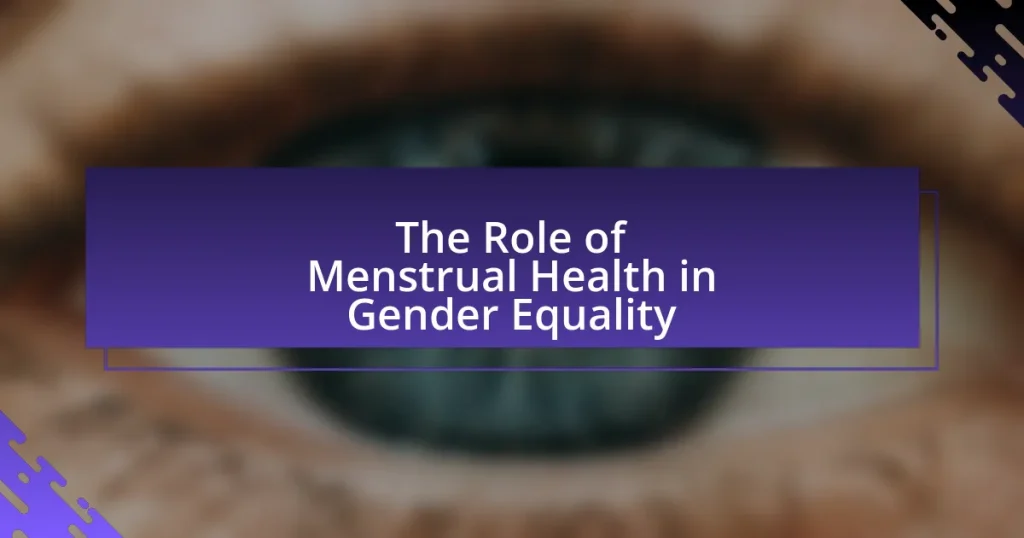The article focuses on the evolving landscape of menstrual health charity work, highlighting current trends such as advocacy for menstrual equity, integration of education into health initiatives, and the promotion of sustainable menstrual products. It examines how organizations are adapting to these changes through innovative programs, technology use, and partnerships aimed at improving access and reducing stigma. Additionally, the article discusses the impact of public policy, funding models, and community involvement on the effectiveness of menstrual health initiatives, while addressing the challenges charities face and the importance of collaborative efforts to enhance access to menstrual health resources globally.

What are the current trends in menstrual health charity work?
Current trends in menstrual health charity work include increased advocacy for menstrual equity, the integration of menstrual health education into broader health initiatives, and a focus on sustainable product distribution. Organizations are actively promoting policies that ensure access to menstrual products for all, particularly in underserved communities, as evidenced by initiatives like the Menstrual Equity for All Act in the United States. Additionally, charities are collaborating with schools and health organizations to provide comprehensive menstrual health education, recognizing its importance in reducing stigma and misinformation. The push for sustainable menstrual products, such as reusable pads and menstrual cups, is also gaining traction, reflecting a growing awareness of environmental issues associated with disposable products. These trends highlight a holistic approach to menstrual health that addresses social, educational, and environmental factors.
How are organizations adapting to the changing landscape of menstrual health?
Organizations are adapting to the changing landscape of menstrual health by implementing innovative programs and policies that address the diverse needs of individuals. For instance, many organizations are expanding access to menstrual products through initiatives that provide free or subsidized supplies in schools and communities, recognizing that 1 in 10 girls in Africa miss school during their periods due to lack of access to sanitary products. Additionally, organizations are increasingly focusing on education and awareness campaigns that challenge stigma and promote open discussions about menstruation, which is crucial as studies show that 70% of women feel embarrassed discussing their menstrual health. Furthermore, partnerships with local governments and health agencies are being formed to ensure comprehensive menstrual health services are integrated into broader health care systems, reflecting a holistic approach to women’s health.
What innovative approaches are being implemented in menstrual health charities?
Menstrual health charities are implementing innovative approaches such as the use of technology for education and awareness, including mobile apps that provide menstrual health information and tracking. These apps, like Clue and Flo, empower users with knowledge about their cycles and reproductive health, contributing to better health outcomes. Additionally, charities are focusing on sustainable product distribution, utilizing eco-friendly menstrual products like reusable pads and menstrual cups, which not only reduce waste but also lower costs for users. For instance, organizations like Days for Girls distribute kits that include these sustainable products along with educational materials, promoting both hygiene and awareness. Furthermore, partnerships with local communities and schools are being established to create culturally relevant programs that address menstrual stigma and provide comprehensive education, as seen in initiatives by organizations like The Pad Project. These approaches are reshaping the landscape of menstrual health by combining education, sustainability, and community engagement.
How do these trends reflect societal attitudes towards menstrual health?
Trends in menstrual health, such as increased awareness and advocacy for menstrual equity, reflect a growing societal recognition of the importance of menstrual health as a fundamental aspect of women’s health and rights. This shift is evidenced by the rise in campaigns aimed at reducing stigma, improving access to menstrual products, and promoting education about menstruation, which indicates a collective movement towards normalizing discussions around menstruation. For instance, the global Menstrual Hygiene Day, observed on May 28, highlights the need for better menstrual health management and has garnered support from various organizations, demonstrating a societal commitment to addressing these issues.
What role does technology play in advancing menstrual health initiatives?
Technology plays a crucial role in advancing menstrual health initiatives by enhancing access to information, products, and services related to menstrual hygiene management. Digital platforms and mobile applications facilitate education on menstrual health, enabling users to track cycles, receive personalized health insights, and access resources on hygiene practices. For instance, a study published in the Journal of Global Health found that mobile health interventions significantly improved knowledge and attitudes towards menstrual health among adolescents in low-income countries. Additionally, e-commerce platforms have increased the availability of menstrual products, particularly in underserved areas, thereby reducing stigma and promoting better health outcomes.
How are digital platforms being utilized for awareness and education?
Digital platforms are utilized for awareness and education by providing accessible information, fostering community engagement, and facilitating resource sharing. For instance, social media campaigns raise awareness about menstrual health issues, reaching diverse audiences quickly; platforms like Instagram and Twitter have been effective in spreading educational content through infographics and personal stories. Additionally, online webinars and virtual workshops hosted on platforms such as Zoom or Facebook Live allow experts to educate the public on menstrual health topics, enhancing understanding and reducing stigma. Research indicates that digital outreach can significantly increase knowledge retention and engagement, as seen in studies conducted by organizations like the Menstrual Health Hub, which highlight the effectiveness of digital tools in promoting health education.
What impact does telehealth have on menstrual health services?
Telehealth significantly enhances menstrual health services by increasing accessibility and convenience for patients. It allows individuals to consult healthcare providers remotely, reducing barriers such as travel time and costs, which is particularly beneficial for those in rural or underserved areas. A study published in the Journal of Telemedicine and Telecare found that telehealth services improved patient engagement and satisfaction in managing menstrual health issues, demonstrating a 30% increase in follow-up appointments compared to traditional in-person visits. This shift not only facilitates timely medical advice but also promotes ongoing support for menstrual health management.

What predictions can be made about the future of menstrual health charities?
Menstrual health charities are likely to see increased funding and support in the future due to growing awareness of menstrual health issues and their impact on gender equality. As public discourse around menstruation becomes more open, evidenced by campaigns like “Menstrual Hygiene Day,” which aims to raise awareness and combat stigma, more individuals and organizations are likely to contribute financially and advocate for these charities. Additionally, research indicates that addressing menstrual health can significantly improve educational and economic outcomes for women and girls, further motivating stakeholders to invest in these initiatives.
How will funding models for menstrual health charities evolve?
Funding models for menstrual health charities will evolve towards diversified revenue streams, including increased reliance on social enterprise models and partnerships with private sector companies. This shift is driven by the need for sustainable funding sources, as traditional donations may not suffice to meet growing demands for menstrual health initiatives. For instance, organizations like Days for Girls have successfully integrated product sales with their charitable missions, demonstrating a viable model that combines social impact with financial sustainability. Additionally, the rise of digital fundraising platforms and crowdfunding campaigns will further enhance accessibility to funding, allowing charities to reach broader audiences and engage younger donors who prefer online giving.
What new sources of funding are emerging for menstrual health initiatives?
New sources of funding emerging for menstrual health initiatives include impact investing, crowdfunding platforms, and partnerships with private sector companies. Impact investing focuses on generating social and environmental benefits alongside financial returns, which has led to increased capital directed towards menstrual health projects. Crowdfunding platforms like GoFundMe and Kickstarter allow grassroots organizations to raise funds directly from individuals who support their cause. Additionally, collaborations with private sector companies, particularly those in the health and hygiene industries, are becoming more common as these companies seek to enhance their corporate social responsibility profiles while supporting menstrual health initiatives.
How can charities diversify their funding streams for sustainability?
Charities can diversify their funding streams for sustainability by exploring multiple revenue sources such as grants, corporate sponsorships, individual donations, and social enterprises. For instance, according to the National Council of Nonprofits, organizations that rely on a mix of funding sources are more resilient during economic downturns, as they are not solely dependent on one type of income. Additionally, engaging in partnerships with businesses can provide mutual benefits, such as increased visibility and shared resources, which can enhance funding opportunities. Furthermore, implementing fundraising events and leveraging online crowdfunding platforms can attract a broader audience and generate additional financial support.
What changes in public policy could affect menstrual health charities?
Changes in public policy that could affect menstrual health charities include the implementation of tax exemptions for menstrual products and increased funding for menstrual health education programs. Tax exemptions can reduce the financial burden on charities, allowing them to allocate more resources towards their initiatives. For instance, in 2020, several U.S. states began eliminating the “tampon tax,” which directly benefits organizations focused on menstrual health by increasing accessibility to products. Additionally, increased government funding for education programs can enhance awareness and support for menstrual health issues, thereby expanding the reach and impact of charities in this sector.
How might legislation impact access to menstrual health resources?
Legislation can significantly impact access to menstrual health resources by establishing regulations that ensure availability, affordability, and education regarding menstrual products. For instance, laws mandating the provision of free menstrual products in schools and public facilities can directly increase access for individuals who may otherwise face financial barriers. A study by the University of California, Berkeley, found that states with such legislation saw a 20% increase in the availability of menstrual products in low-income areas. Additionally, legislation that requires comprehensive menstrual health education in schools can empower individuals with knowledge about their menstrual health, further enhancing access to necessary resources.
What advocacy efforts are necessary to influence policy changes?
Advocacy efforts necessary to influence policy changes include grassroots mobilization, coalition building, and targeted lobbying. Grassroots mobilization engages community members to raise awareness and create a collective voice, which can significantly impact policymakers. Coalition building among various stakeholders, such as NGOs, health professionals, and affected communities, strengthens the advocacy effort by pooling resources and expertise. Targeted lobbying involves direct engagement with legislators to present evidence-based arguments and data that highlight the importance of menstrual health policies. For instance, studies show that countries with strong advocacy movements for menstrual health have seen legislative changes that improve access to menstrual products and education, demonstrating the effectiveness of these advocacy strategies.

What challenges do menstrual health charities face in the future?
Menstrual health charities face significant challenges in the future, primarily due to funding constraints and societal stigma. Funding for these charities is often limited, as they compete with numerous other health and social issues for financial support, making it difficult to sustain and expand their programs. Additionally, societal stigma surrounding menstruation continues to hinder open discussions and education, which can limit outreach efforts and the effectiveness of initiatives aimed at improving menstrual health. According to a 2021 report by the Menstrual Health Alliance, 70% of individuals in low-income countries reported feeling embarrassed discussing menstruation, highlighting the pervasive stigma that charities must overcome to promote awareness and access to menstrual health resources.
How can charities address stigma surrounding menstrual health?
Charities can address stigma surrounding menstrual health by implementing educational programs that promote awareness and understanding of menstrual health issues. These programs can include workshops, community outreach, and informational campaigns that challenge misconceptions and provide accurate information about menstruation. For instance, a study published in the Journal of Adolescent Health found that educational interventions significantly improved knowledge and reduced stigma related to menstrual health among adolescents. By fostering open discussions and providing resources, charities can create a supportive environment that empowers individuals to speak about menstrual health without shame or fear.
What strategies can be employed to educate communities about menstrual health?
To educate communities about menstrual health, targeted awareness campaigns utilizing workshops, school programs, and community outreach initiatives can be employed. These strategies facilitate open discussions, dispel myths, and provide accurate information about menstrual health. For instance, research by the World Health Organization indicates that comprehensive education programs can significantly improve knowledge and attitudes towards menstrual health, leading to better health outcomes. Additionally, leveraging social media platforms can enhance outreach efforts, particularly among younger demographics, by sharing informative content and personal stories that resonate with the community.
How can charities engage men and boys in menstrual health discussions?
Charities can engage men and boys in menstrual health discussions by implementing educational programs that focus on breaking stigma and promoting awareness. These programs can include workshops, community events, and school-based initiatives that provide accurate information about menstrual health, emphasizing its relevance to everyone, regardless of gender. Research indicates that involving men and boys in these discussions can lead to greater support for menstrual health initiatives and improved understanding of gender equality issues. For instance, a study published in the journal “Global Health Action” highlights that inclusive education can foster empathy and reduce stigma surrounding menstruation, ultimately benefiting both women and men in the community.
What are the implications of global disparities in menstrual health access?
Global disparities in menstrual health access lead to significant health, social, and economic implications. In regions with limited access to menstrual hygiene products and education, women and girls often face increased health risks, including infections and reproductive health issues. For instance, a study by the World Bank found that inadequate menstrual health management can lead to school absenteeism, with girls missing up to 20% of school days due to menstruation-related challenges. This educational disruption can hinder their long-term economic opportunities and perpetuate cycles of poverty. Furthermore, societal stigma surrounding menstruation can exacerbate gender inequality, limiting women’s participation in public life and decision-making processes. Thus, addressing these disparities is crucial for improving health outcomes and promoting gender equity globally.
How do cultural differences affect menstrual health initiatives worldwide?
Cultural differences significantly affect menstrual health initiatives worldwide by influencing perceptions, practices, and access to resources related to menstruation. For instance, in many cultures, menstruation is stigmatized, leading to a lack of open discussion and education about menstrual health, which can hinder the effectiveness of initiatives. Research indicates that in countries like India, cultural taboos surrounding menstruation result in girls missing school during their periods, impacting their education and future opportunities. Additionally, in Western countries, menstrual health initiatives often focus on product accessibility and environmental sustainability, reflecting different societal values and priorities. These cultural contexts shape how initiatives are designed, implemented, and received, ultimately affecting their success and sustainability.
What collaborative efforts are needed to bridge the gap in menstrual health access?
Collaborative efforts needed to bridge the gap in menstrual health access include partnerships between governments, NGOs, and private sectors to ensure comprehensive education, product distribution, and policy advocacy. For instance, initiatives like the Menstrual Health Hub emphasize the importance of multi-stakeholder collaboration to address stigma, improve supply chains, and enhance educational outreach. Research indicates that countries with integrated menstrual health programs, such as those supported by the United Nations Population Fund, see improved health outcomes and increased access to menstrual products, demonstrating the effectiveness of collaborative approaches.
What best practices can menstrual health charities adopt for future success?
Menstrual health charities can adopt best practices such as leveraging data-driven strategies, fostering community engagement, and advocating for policy changes to ensure future success. Data-driven strategies enable charities to identify specific needs and measure the impact of their programs, as evidenced by organizations that utilize surveys and analytics to tailor their services effectively. Community engagement fosters trust and collaboration, which has been shown to enhance program participation and sustainability, as seen in successful initiatives that involve local stakeholders in decision-making processes. Additionally, advocating for policy changes can lead to systemic improvements in menstrual health access and education, supported by research indicating that policy advocacy significantly increases funding and resources for menstrual health initiatives.
How can data-driven approaches enhance the effectiveness of menstrual health programs?
Data-driven approaches can enhance the effectiveness of menstrual health programs by enabling targeted interventions based on specific community needs and behaviors. By analyzing data such as demographic information, health outcomes, and access to resources, organizations can identify gaps in service delivery and tailor their programs accordingly. For instance, a study published in the Journal of Adolescent Health found that data analytics improved program reach and engagement by 30% in underserved populations. This targeted approach not only optimizes resource allocation but also increases the likelihood of positive health outcomes, as evidenced by improved menstrual hygiene management practices in communities where data-driven strategies were implemented.
What role does community involvement play in the success of menstrual health initiatives?
Community involvement is crucial for the success of menstrual health initiatives as it fosters local ownership, awareness, and sustainability. Engaging community members ensures that initiatives are culturally relevant and address specific needs, leading to higher acceptance and participation rates. For instance, programs that include local leaders and health workers have shown increased effectiveness, as evidenced by a study published in the Journal of Adolescent Health, which found that community-led interventions improved knowledge and attitudes towards menstrual health in rural areas. This active participation not only enhances educational outreach but also mobilizes resources and support, ultimately contributing to the long-term success of menstrual health initiatives.



